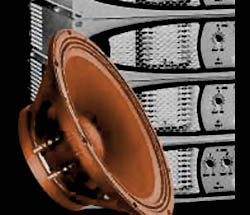
EBP: Calculated by dividing Fs by Qes. The EBP figure is used in many enclosure design formulas to determine if a driver is more suitable for a closed or vented design.
An EBP close to 100 usually indicates a driver that is best suited for a vented enclosure. On the contrary, an EBP closer to 50 usually indicates a speaker best suited for a closed box design.
This is merely a starting point. Many well-designed loudspeaker systems have violated this rule of thumb! Qts should also be considered.
Xmax/Xmech: Short for “maximum linear excursion.” Driver output becomes non-linear when the voice coil begins to leave the magnetic gap.
Although suspensions can create non-linearity in output, the point at which the number of turns in the gap (see BL) begins to decrease is when distortion starts to increase.
Xmax is voice coil height minus top plate thickness, divided by two, while Xmech (as expressed by Eminence) is the lowest of four potential failure condition measurements times two: Spider crashing on top plate, and/or voice coil bottoming on back plate. Voice coil coming out of gap above core; physical limitation of cone.
Take the lowest of these measurements and then multiply it by two. This gives a distance that describes the maximum mechanical movement of the cone. (For Eminence transducers, half the Xmech value represents the one-way excursion limit that if exceeded would cause permanent damage.)
Sd: This is the actual surface area of the cone, normally given in square centimeters.
Zmax: Represents the driver’s impedance at resonance.
Usable frequency range: Manufacturers use different techniques for determining this, and most are recognized as acceptable in the industry. However, they can arrive at
different results.
Technically, many drivers are used to produce frequencies in ranges where they would theoretically be of little use. As frequencies increase, the off-axis coverage of a transducer decreases relative to its diameter.
At a certain point, the coverage becomes ‘beamy’ or narrow like the beam of a flashlight.
See the chart at left – it demonstrates at what frequency this phenomenon occurs relative to the size of the transducer. If you’ve ever stood in front of a guitar amplifier or loudspeaker cabinet, then moved slightly to one side or the other and noticed a different sound, you have experienced this phenomenon.
Clearly, most two-way loudspeaker systems ignore the theory and still perform quite well.
Power handling: A transducer needs to be capable of handling the input power it’s provided. The general rule of thumb is that a power amplifier, when reproducing any program source, “provides” long term- thermal power that is approximately 1/8 its maximum rated output before clipping (rap music excluded).
This is why even UL testing for power amps is done, and listed for on the back of the amp, at 1/8 the rated output power of the amp.

